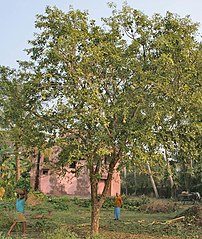Botanical Name : Holarrhena Antidysenterica
Family : Apocynaceae
Genus:Wrightia
Species:W. antidysenterica
Kingdom: Plantae
Order:Gentianales
Common Name : Bitter Oleander, Connessi Bark, Kurchi Bark, , Dysentery Rose Bay, Tellicherry Bark,Kuda,Kutaj,Kutaja
. It is also known as “White Angel” in the Philippines
Bengali name :Kurchi
Part Used : Bark, Seeds
Habitat :Holarrhena Antidysenterica is native to tropical Himalayas, going up to an altitude of ,1,200 m. Also found throughout many forests of India, in Travancore, Assam and Uttar Pradesh. Grows wild in mountains
Description:
It is a tall shurb or small tree, evergreen in nature.Leaves are smooth large, ovate in shape; and about 15-31 cms. long and 10 cms. broad.Flowers are cream coloured, fragrant and borne in bunches .The plant flowers profusely during February-March. fruits are thin and cylindrical, with two follicles attached together at distal ends. Special characteristics of Holarrhena antidysenterica. Fragrant flowers and twin fruits….
Click to see the pictures..………….....(01)........(1).…..(2)......(3)...
Medicinal Uses:
It is one of the best drug for diarrhoea. In chronic diarrhoea & to check blood coming from stool, it should be given with Isobgol, caster oil or Indrayav.
According to Ayurveda, the bark is useful in treatment of piles, skin diseases and biliousness.
The bark is used externally in case of skin troubles. The bark is mostly mixed with cow urine and applies it in affected parts. In treatment of urinary troubles, the bark is given with cow milk. The fresh juice of bark is considered good to check the diarrhoea. In bleeding piles Decoction of Kutaj bark with sunthi checks mucus & blood. Application of this herb is useful in Rh. Arthritis & Osteoarthritis. The bark is used in chest affections and as a remedy in diseases of the skin and spleen. It is a well known herb for amoebic dysentery and other gastric disorders.
Kutaja bark has been used in India in the treatment of amoebic dysentery and liver ailments resulting from amebiasis. Conessine from the bark killed free living amoebae and also kills entamoeba histolytica in the dysenteric stools of experimentally infected kittens. It is markedly lethal to the flagellate protozoon. It is antitubercular also. Conessine produced little effect on Trichomonas hominis but was markedly lethal to the flagellate protozoon. It is a well known drug for amoebic dysentery and other gastric disorders. A clinical study records the presentation of forty cases with amochiasis and giardiasis. The efficacy of kutaja in intestinal amochiasis was 70%. Good response was also observed in Entamoeba histolytica cystpassers when treated with kutaja bark. The flowers improve appetite. The seeds are cooling, appetising and astringent to the bowels.
Today Conessi seed is used as a remedy for dysentery, diarrhea, intestinal worms, and irregular fever, though the actions are milder than that of the bark. Conessi bark is used to treat dysentery, but also is used for treating hemophilia disorders, skin diseases, and loss of appetite. It also works well in treating indigestion, flatulence, and colic. The British materia medica regards it as one of the most valuable medicinal products of India.
It also has been used to treat various skin and stomach disorders. It is an astringent tonic for the skin. It is used against hot disorder of the gall bladder and stops dysentery. Relieves cholecystitis and diarrhea associated with fever. It is used in disorders of the genitourinary system and is helpful in the cases of impotence, spermatorrhea and seminal debilities.
Disclaimer:
The information presented herein is intended for educational purposes only. Individual results may vary, and before using any supplements, it is always advisable to consult with your own health care provider.
Resources:
http://www.motherherbs.com/holarrhena-antidysenterica.html
http://green-source.blogspot.com/2009/06/kuda-kutaj-holarrhena-antidysenterica.html
http://www.herbnet.com/Herb%20Uses_IJK.htm
http://www.alibaba.com/product-tp/108122069/Holarrhena_Antidysenterica.html
http://www.greenearthproducts.net/ficus-bengalensis.html
http://en.wikipedia.org/wiki/Wrightia_antidysenterica














































